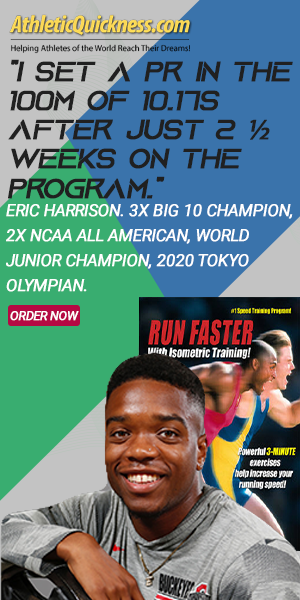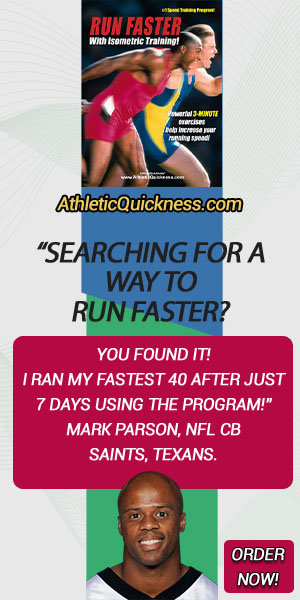Developing Bat Speed and Power in the
Baseball Swing
THE BASEBALL SWING: Part 2 of 4 – The Loading Phase
Part 1 – The Stance
Part 2 – The Loading Phase
Part 3 – The Launch Phase
Part 4 – The Follow Through
The Loading Phase
The loading phase takes us from the stance position to the launching position. There are five noticeable movements that take place during this phase and they are:
1) backward movement of the shoulders and arms
2) backward rotation of the spine
3) beginning of the timing step
4) cocking of the hips
5) cocking of the wrists
- Backward Movement of the Shoulders and Arms
The first noticeable movement that takes place during the loading phase is the backward movement of the shoulders and arms toward the catcher. This action helps to load, or stretch, different muscles in each shoulder that will be released, or contracted, later during the swing.Take a look at a sequence of movements from directly across home plate. Starting in the stance position in Figure 1-8a, follow the movement of both shoulders and arms in subsequent Figures 1-8b, 1-8c and 1-8d.Here we see both shoulders and arms moving in the same direction, back and away from the pitcher however, each shoulder using a different set of muscles to get there.
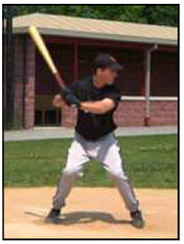


Figure 1-8a. Figure 1-8b. Figure 1-8c. Figure 1-8d
First, the movement of the leading left arm and shoulder across the body and away from the pitcher is known as shoulder adduction. See Figure 1-8d. This is caused mainly by the action of the pectoralis major muscle with help from the coracobrachialis, latissimus dorsi and teres major muscles, all on the left side of the body. The left shoulder ends up shrugged or elevated in this position which is a function of the upper fibers of the trapezius muscle. The left scapula or shoulder blade is also protracted, or moved anterior, toward the front of the body in this position. This motion is caused by the left serratus anterior muscle.
The contraction of these muscles stretches or loads the muscles on the back side of the same leading left shoulder, namely the posterior deltoid, rhomboids and middle fibers of the trapezius muscles. These muscles are now fully loaded, or stretched, and ready to deliver fast bat speed.
The movement of the back (right) arm away from the pitcher and laterally raised away from the player’s body is known as shoulder abduction. See Figure 1-8d. This is caused by the supraspinatus and middle deltoid muscles. The right scapula may also be slightly shrugged or elevated in this position depending on the player’s style and if so, this motion is caused by the upper fibers of the trapezius muscle.
The contraction of these muscles stretches or loads the antagonist or opposing muscles on the same side of the body, namely the latissimus dorsi, teres major and serratus anterior muscles. These muscles are now fully loaded and ready to help swing the bat with speed and power from this position.
- Backward Rotation of the Spine
At the same time the shoulders and arms are moving backward, muscles along the spine and abdomen are also contracting to help turn and rotate the spine (including the chest, abdomen and upper body) in the same direction. To see this, look at a similar sequence of movements from behind home plate.



Figure 1-9a. Figure 1-9b. Figure 1-9c. Figure 1-9d
Starting in the stance position in Figure 1-9a, where only the back shoulder is visible, follow the movement of the upper body in Figures 1-9b, 1-9c and 1-9d. Here we see the chest, abdomen and upper back also being rotated away from the pitcher to the point where now both shoulders are visible.
This action of upper body and spine rotating away from the pitcher gives the appearance that the shoulders are rotating backward when in effect it is the spine that is rotating, carrying the shoulders with it. This backward rotation of the spine is caused by the contraction of the lateral spine rotators.
To get the body to rotate back and away from the pitcher, the lateral spine rotators on the left side of the body (‘front’ side for the right-hand batter) needs to contract or shorten. In doing so, the trunk is turned to the side opposite to that from which these muscles act -to the right, or backward.
This may be opposite of what you might think however, this has to do with the upward and oblique orientation of these muscles in the spine. The contraction of these lateral spine rotators on the left side of the body stretches and loads the exact same muscles on the opposite, or right, side of the body, which will be needed during the forward movement of the bat.
- Beginning of the Timing Step
Immediately after the shoulders and arms have started to move toward the catcher and the spine (including the chest, abdomen and upper body) has rotated as well, a short timing step with the front leg begins to occur.Look again at Figures 1-9a through 1-9d and you will notice that as the player’s body has turned inward or backward, his front foot has come off the ground signifying the beginning of this timing step.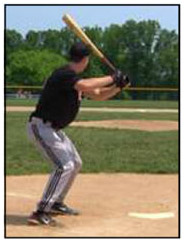



Figure 1-9a. Figure 1-9b. Figure 1-9c. Figure 1-9d
Some players may raise their foot higher than this while others may still keep their toes in contact with the ground. Some will even turn their front knee inward to facilitate the hip-cock (discussed next), though this is not part of this batter’s technique here.
But, however high or low the beginning of this timing step is, the first effect is to force the back leg to carry the player’s weight, however since his feet are shoulder-width apart at the start and not directly underneath him, the natural tendency once in this position will be to ‘fall’ forward thereby creating valuable momentum in the process.
Another effect of the beginning of the timing step is that it also places an additional load on the big muscles of the back thigh and buttocks. Looking again at Figures 1-9a through 1-9d, we see this additional load on the back leg taking place as the player’s position ends up squatted down a little more when the front foot comes off the ground. The muscles in the back leg that are further loaded during this movement are the hip extensors and knee extensors.
Besides creating forward momentum and loading the powerful muscles of the back leg, another purpose of the timing step is to cock the hips, and this is discussed next.
- Cocking of the Hips
Cocking of the hips refers to the backward rotation of the hips away from the pitcher and as just mentioned, it occurs in unison with the beginning of the timing step. You can see this backward turn of the hips in Figures 1-8d Figure 1-9d above. As the front leg has come off the ground both hips rotate backward, toward the catcher, and now the front side of both hips are visible.Cocking the hips is driven by momentum created by the backward movement of the shoulders/arms and the rotation of the spine along with a shift in weight to the back leg and the inward turn of the front knee. Since the back foot remains in contact with the ground during this time, it is forced to plant firm. This creates a pivot point around the back hip for the weight of the entire body to rotate.As a result, the rear hip (thigh) is forced anatomically into medial or inward rotation. This in turn stretches the powerful external hip rotators in this same rear hip. This is the primary effect of cocking the hips, and the stretching of these strong muscles stores an incredible amount of elastic energy that when timed properly, can be released to help carry out a very powerful rotational bat swing. This is why these are the muscles everyone needs to target as part of th eir training! - Cocking of the Wrists
Cocking of the wrists is an action the hands perform on the bat handle at the tail end of the loading phase (Figure 1-10a) and into the first part of the launching phase (Figure 1-10b). Its purpose is to break inertia, or prevent the bat from coming to a dead stop, and create a rapid recoiling effect with the bat-head at the end of the player’s furthest backswing.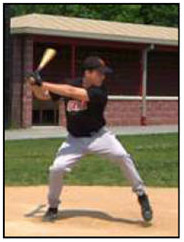

Figure 1-10a. Figure 1-10b
Figure 1-10a. End of loading phase. (same as Figure 1-8d.)
Figure 1-10b. Beginning of launching phase. (same as Figure 1-11a in Part3)
As the shoulders, arms and spine have moved and rotated backward as seen in Figure 1-10a, the hips, being the last to rotate back in the loading phase, are now the first to recoil and begin their explosive contraction forward in the launching phase seen in Figure 1-10b.
Comparing the back hip’s position in Figure 1-10b with that of Figure 1-10a, we can see that the hips have already begun their turn toward the pitcher, and this rapid change of direction by the hips occurs a split second before the head of the bat reaches its farthest backswing position.
The farthest backswing position of the bat is accomplished by a pushing of the top hand on the bat-handle, so the bat-head ends up leaning back toward the hitter. This represents the cocking of the wrists and is shown in Figure 1-10b.
Compare the bat-head position in this figure with that in Figure 1-10a, and you will see the bat-head is now closer to the player’s head, which is a sign that the hands and wrists are still loading, and this occurs even though the hips have already started to launch forward.
Since cocking the wrists occurs in the opposite direction as the path of the swing resulting in the bat-head pushed to its farthest backswing position, and because it occurs when the body is transitioning into the launching phase, it represents a point of maximum coiling power in the body.
If timed at the right moment, this little extra thrust of the wrists cocking the hands on the bat-handle while the hips start to unload will create a rapid change in direction of the bat-head, which increases the body’s ability to create, store and release incredible amounts of elastic energy in the arms and shoulders resulting in incredible power and speed in the bat swing.
Always glad to help!
Dr. Larry Van Such
Part 1 – The Stance
Part 2 – The Loading Phase
Part 3 – The Launch Phase
Part 4 – The Follow Through

